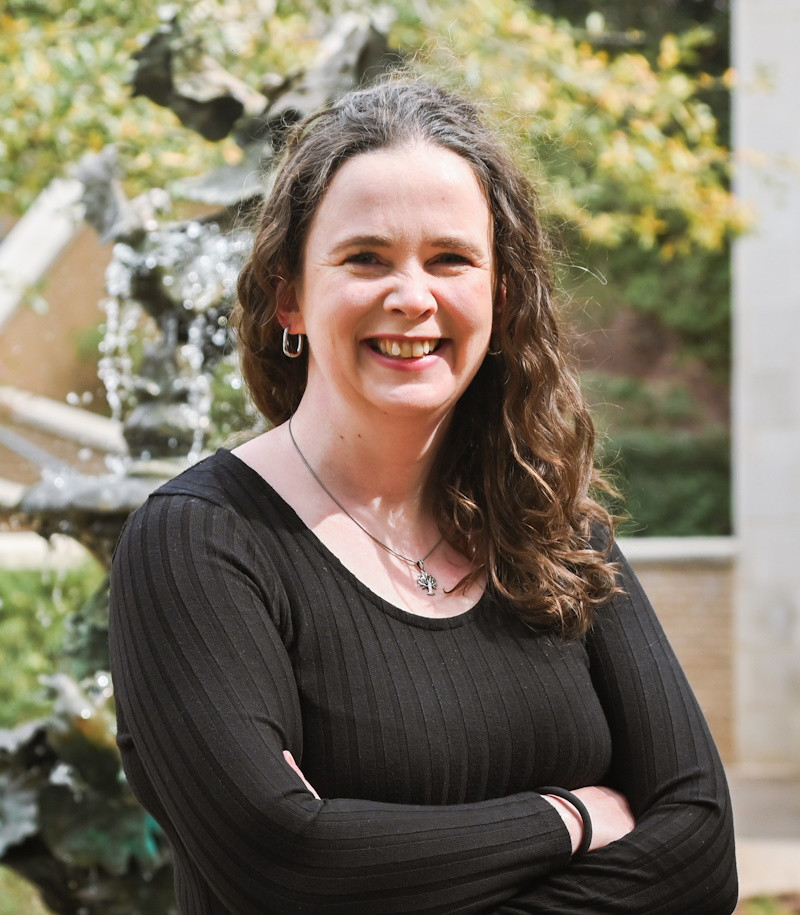March 20, 2024 | Erin Bluvas, bluvase@sc.edu
In the rural coastal community where Laura Langan grew up, a nearby textile plant routinely dumped untreated wastewater directly into the local fishing bay.
“As a young child I remember asking why we had to hold our breath for up to a minute to get to smell the sea air and not rotten eggs while outside,” the Ireland native says. “The visual of black sand into white sand and olfactory consequences of this are still vivid to this day. I never did get a good answer.”
As an assistant professor in the Department of Environmental Health Sciences, Langan is looking for her own answers to the array of impacts that result from the nexus of human and environmental interactions. Despite her interest in science and its role in the farming community that surrounded her, young Langan knew of no career path in the field outside of teaching high school students or becoming a medical doctor. So she forged one herself.
As an undergraduate at the National University of Galway, Langan got the science foundation that was not offered in her K12 curriculum. She then moved right into her master’s (Fisheries Biology at Atlantic Technological University, Ireland) and doctoral (Environmental Toxicology at University of Plymouth, United Kingdom) programs. Here, Langan immersed herself in the development of a 3D gastrointestinal model that would allow her to assess the safety of pharmaceutical chemicals on human and animal health without endangering aquatic life as test subjects.
She continued this work as a postdoctoral research fellow on two different projects at her Ph.D. alma mater and as a research scientist at Baylor University. Her work has evolved to focus on protecting aquatic animals used in science through the repurposing and development of new methods/approaches (e.g., her 3D gastrointestinal model) and understanding human and environmental impacts by studying the intestine – a multifunctional organ that plays critical functions such as digestion and immune response and is the site of many chemical interactions.

“The joy and freedom of science is the opportunity to explore, and continuously educate yourself about its interconnectedness,” Langan says. “Working in diverse areas, I realized two things that later came to shape my interest in them. The enormous scale and quantity of animals used in assessments of toxicity, safety assessments and fundamental understanding of biological processes across the organismal spectrum was immense and shocking, especially when alternatives are continuously becoming available. And how little is known about one of the biggest organs across vertebrates – the intestine.”
In addition to ethically conducting risk assessments of pharmaceuticals, personal care products, natural products, harmful algal bloom toxins and other contaminants of emerging concern, Langan’s lab also uses wastewater-based epidemiology to study various diseases, particularly those that originate in the gastrointestinal system. Though little is known about these types of illnesses, they are widespread and carry significant economic and social consequences. Langan’s work aims to illuminate associated trends and impacts to address these public health challenges.
She became involved in this type of surveillance work during the COVID-19 pandemic, when she experienced the power of unconventional partnerships, commitment to protecting at-risk populations, and applying/building her toolbox to enrich and improve community health. The ability to pivot from her primary research to collaboratively combat a public health crisis is exactly why Langan loves being a scientist.
“I love the challenge of science, the continuous learning, problem solving and divergent paths,” she says. “When I started my career, all I thought about was working in a very defined area, but now, my goal is to help develop solutions to help society and improve the quality of both human life and the environment.”
This philosophy is what drew Langan to the Arnold School. She loves her department’s One Health approach to working at local, regional, national and global levels to achieve optimal outcomes for human and environmental health.
“This goal necessitates a school that supports a kind, passionate and interdisciplinary faculty coming from all parts of the world, with a shared aim of improving public health for everyone,” Langan says. “I get to work with some of the best scientists in their disciplines, who are dedicated to improving and giving back to South Carolina communities, while also ensuring continuity of this work. What more could I ask for?”
“Laura’s focus on molecular toxicology is a tremendous addition to our faculty in environmental health sciences, especially her focus on the intestine as an organ system, which moves away from whole animal models and into less invasive toxicological exposure models,” says clinical professor and department chair Geoff Scott. “The U.S. EPA and other federal agencies are moving away from live animal toxicology models into more focused organ system models that are more predictive of human health effects. Laura’s combination of toxicology and molecular biology give her a unique skill set to interact with faculty throughout the Arnold School of Public Health as well as throughout USC in addressing 21st century environmental issues.”
Langan is also looking forward to mentoring students. Her goal is to break down stereotypes about who should pursue careers in science and increase the diversity and sheer number of students with backgrounds in environmental health, toxicology and lab experience.
“I hope to be a positive female influence and role model to others coming after me, teaching, supporting, promoting and advocating for the younger generations to not limit themselves based on societal norms,” says Langan, who views science as an important equalizer. “I strongly believe that having students work on their own projects and conducting hands-on research in the lab empowers them to take ownership and leadership both in science and their personal and professional development, helping them shape the path towards their future careers.”